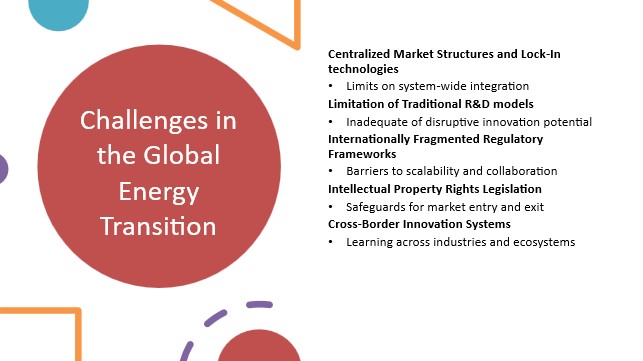Background
The energy transition – that is, the shift toward the efficient and widespread use of renewable energy sources – is becoming technically feasible, but the markets have not yet fully transformed; fossil energy sources still dominate globally. The need for a systemic transformation and scalable solutions is therefore evident, both from the perspective of the state of the environment and international security.
Significant Problem and Its Economic and Social Significance
The global energy transition faces systemic barriers that impede innovation and scalability. Five interrelated challenges are particularly critical:
1. Centralized Market Structures and Lock-In Technologies (MAP)
Current energy markets exhibit high centralization and technological lock-in, limiting integration across energy generation, storage, distribution, and consumption. This fragmentation obstructs the development of cohesive, system-wide innovations and slows the adoption of renewable and flexible solutions.
2. Limitations of Traditional R&D Models (DESIGN)
Conventional research and development approaches are predominantly incremental and risk-averse. These models fail to identify and exploit disruption potential, resulting in slow innovation cycles. Finland’s energy R&D ecosystem requires agile, high-risk methodologies that enable rapid prototyping, iterative design, and adaptive problem-solving.
3. Internationally Fragmented Regulatory Frameworks (BUILD)
Regulatory heterogeneity across jurisdictions creates barriers to commercial scalability and cross-border collaboration. Misalignment with global standards constrains Finland’s ability to position itself as a leader in energy technology and hinders participation in international markets.
4. Intellectual Property Rights (IPR) Legislation (BUILD)
While IPR frameworks safeguard innovation, they also shape competitive dynamics during market entry and exit phases. Effective IPR strategies are essential to protect emerging technologies while fostering fair competition and knowledge diffusion.
5. Cross-Border Innovation Systems (MAP–DESIGN–BUILD)
Transformative innovation increasingly depends on learning across industries and ecosystems. Benchmarking, cross-sectoral collaboration, and “benchlearning” are prerequisites for creating disruptive solutions that transcend traditional industry boundaries.

What Do We Do in This Project?
The Map–Design–Build (MDB, we use also the term Transformation Design) concept provides a structured and systematic framework for identifying and responding to disruptions and opportunities within energy value chains. This strategic approach consists of three interlinked phases:
- Map: Mapping the value chain and identifying disruption points by analyzing actors, processes, and associated cash flows. This phase enables a comprehensive understanding of value creation and cost structures across the chain.
- Design: Designing and prototyping substitute products, services, and projects that address identified disruption points. This involves conceptualizing alternative configurations and leveraging digital technologies to accelerate solution development.
- Build: Implementing the disruption portfolio and executing scale-up projects to achieve measurable transformation in the market.
In our project, we operationalize this framework by replacing, inserting, consolidating, or diverting value chain building blocks (actors and their processes). Digital accelerators such as artificial intelligence (AI) and digital twins play a critical role in expediting these processes across our three cases:
- The Pilot-Scale Battery Manufacturing
- The Zero-Emission Data Centre
- The Self-Sufficient Green House
A key principle guiding this work is the Technology Readiness Level (TRL) framework, which determines the appropriate type of development project for the subsequent co-innovation phase:
Low TRL: University-led research projects focusing on early-stage technological exploration.
Mid TRL: Joint company–university projects aimed at validation and prototyping.
High TRL: Company-led projects emphasizing commercialization and market deployment.
The mapping process involves a detailed analysis of actors and processes within the value chain, along with their financial flows. This enables the identification of segments that generate the highest value, which in turn provides the foundation for determining disruption points. These disruption points are then formulated into actionable strategies that may replace, insert, consolidate, or divert existing actors or building blocks.
Finally, based on the nature of each disruption point, a practical research or development project is defined to create the new product, service, or business model required. The project owner is determined by the readiness level of the development target (e.g., TRL), ensuring that universities and companies are activated appropriately—either to develop solutions at an early stage or to deploy existing solutions in new application areas.